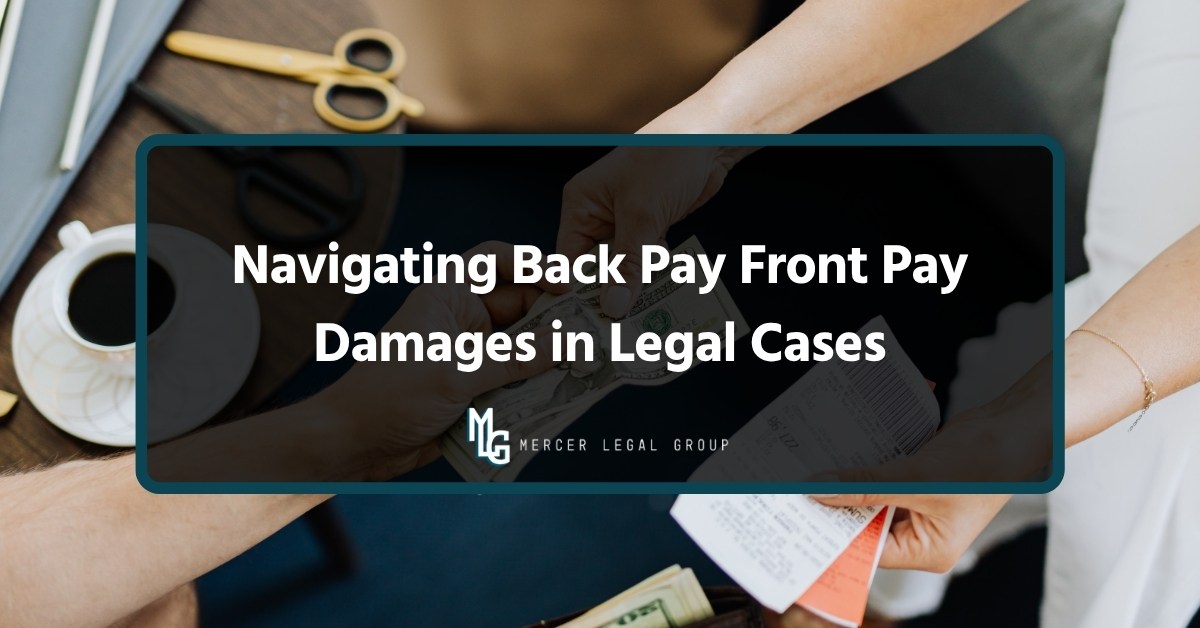Navigating back pay and front pay damages in legal cases involves understanding how these forms of compensation are calculated and why they matter in employment law. Back pay covers lost wages and benefits from the time of wrongful termination or discrimination to the date of resolution, while front pay compensates for future lost earnings when reinstatement isn’t possible. Together, these damages ensure employees are fully compensated for both past and future financial losses, promoting fairness and accountability in workplace disputes.
At Mercer Legal Group, our attorneys have extensive experience and expertise in employment law, guiding clients through complex cases involving back pay and front pay damages. We have a strong track record in wrongful termination and wage dispute claims, and we’re known for our ability to secure fair outcomes. Our team keeps up-to-date with the latest legal standards, including IRS and EEOC guidelines, to make sure we handle every case accurately and honestly. Contact us today for a confidential consultation and let us help you secure the justice and compensation you deserve.
This blog will explore the concepts of back pay and front pay damages, explaining how they are calculated, when they apply, and what factors influence compensation in legal cases.
What Is the Difference Between Back Pay and Front Pay Damages?
Front and back pay are both forms of compensation in employment law, serving as equitable remedies designed to address different times and circumstances. Back pay covers wages and benefits an employee lost from the time of wrongful termination or unlawful action up to the date of resolution or reinstatement. It compensates for past financial losses and is often awarded alongside compensatory or punitive damages when the employer’s conduct was particularly egregious.
In contrast, front pay compensates for lost future earnings when reinstatement is not practical due to strained relations or other factors. This remedy estimates the amount the employee would have earned had the wrongful termination not occurred, helping ensure fair recovery for future loss. Together, front and back pay reinforce the principle of full compensation, balancing both past and future harms in employment disputes.
What Is Back Pay in Employment Law Damages?
Back pay refers to the wages and benefits an employee should have received but did not due to an employer’s unlawful action, such as discrimination, unlawful termination, sexual harassment, or retaliation cases. It serves as a form of compensatory damages, intended to restore the employee’s financial position to what it would have been had the violation not occurred.
The calculation of back pay typically includes base salary, overtime, bonuses, and benefits like health insurance or retirement contributions. Courts or labor agencies may award back pay in cases involving discrimination based on national origin, wrongful dismissal, or wage disputes, making it a key remedy in employment law to ensure fairness, accountability, and justice for affected employees.
How is Front Pay Calculated?
Front pay is the estimated future income that an employee would have earned if they had not been wrongfully terminated or subjected to discrimination. Courts may award front pay as compensation when reinstating the employee is not feasible due to workplace hostility, retaliation, or the elimination of their position. This remedy allows employees to recover lost future earnings, providing financial stability while they seek comparable employment. The amount of front pay is meant to be a fair and reasonable guess of how much the employee would have made over time.
Several factors influence the calculation of front pay, including the employee’s age, position, salary history, length of employment, and future job prospects. Courts also consider the time it may take for the individual to secure comparable employment, as well as their potential for career advancement. Because front pay involves estimating future losses, it often requires expert financial analysis to ensure an accurate and equitable award.
How Is Back Pay Calculated in Back Pay Front Pay Damages Claims?

In employment law, back pay is calculated by determining the total wages and benefits an employee would have earned from the date of wrongful termination or the unpaid period up to the date of reinstatement or judgment. This includes base salary, overtime, bonuses, commissions, and the value of lost benefits such as health insurance or retirement contributions. The goal is to restore the employee to the financial position they would have been in if their former employer had not engaged in unlawful conduct.
Courts and labor agencies may also consider additional factors, such as whether reinstatement to the previous position is possible and the employee’s efforts to mitigate damages. The back pay amount is reduced by any income the employee earned or could have reasonably earned during the period in question, and interest may be added to account for delayed payment.
Proper documentation, such as payroll records, employment contracts, and tax statements, is essential to ensure accuracy, fairness, and compliance in calculating the final award.
What Are the Methods for Calculating Back Pay?
The timeframe for back pay usually spans from the date of wrongful termination or pay violation to the date of reinstatement, settlement, or judgment. To ensure accuracy, employers and courts rely on wage documentation such as pay stubs, employment contracts, and tax records to establish the employee’s regular earnings, including salary, overtime, bonuses, and benefits.
Once the total potential earnings are identified, certain deductions are applied. These include any income the employee earned from other jobs during the same period (to account for mitigation of damages) and applicable taxes or withholdings. In some cases, interest is added to compensate for the delay in payment. This process ensures that the back pay award is based on the employee’s actual economic loss and brings them as close as possible to their rightful financial position.
What Are Employer Defenses to Back Pay?
Employers facing back pay claims often raise several defenses to limit or avoid liability, depending on their actions and the circumstances of the case. One common defense is mitigation of damages, which argues that the employee failed to make reasonable efforts to obtain comparable work after being terminated or constructively discharged. If the employer can prove that the employee did not actively seek or accept suitable employment, the amount of back pay owed may be reduced or denied altogether.
Another key defense involves the sufficiency of evidence and compliance with anti-discrimination laws. Employers may challenge the accuracy or completeness of the employee’s proof of lost wages, including pay records, time sheets, or employment documentation. Courts may also consider the employer’s size and available resources when determining liability or assessing damages. By presenting credible evidence and demonstrating good-faith compliance, employers can effectively contest or reduce back pay awards in employment disputes.
Can Back Pay Be Awarded for Wrongful Termination?
Back pay can be awarded in wrongful termination cases when an employee proves they were unlawfully dismissed. Back pay represents the wages and benefits the employee would have earned from the date of termination until the date of reinstatement or judgment.
Courts or labor agencies typically grant back pay when the termination violates employment laws, such as discrimination, retaliation, or breach of contract. To recover wages lost, an employee must provide clear evidence of the employer’s wrongful conduct.
However, the amount of back pay awarded is determined by several factors, including the employee’s efforts to mitigate damages by finding comparable work. When an employee finds new employment, the earnings from that job are typically deducted from the back pay award. Back pay restores the employee’s “wholeness” by putting them in the financial position they would have been in if they hadn’t been wrongfully fired.
Legal Criteria for Awarding Back Pay Front Pay Damages
Back pay damages are typically awarded when an employee proves that an employer’s unlawful action directly caused an injury resulting in lost wages or benefits. The primary legal criteria include establishing clear evidence of wrongful conduct, such as discrimination, retaliation, or breach of contract, and demonstrating that this action led to measurable financial harm.
When a court finds that discrimination occurred, back pay serves to restore the employee to the financial position they would have held absent the employer’s misconduct. It compensates for past losses, including missed wages, benefits, and other earnings the employee would have received if not for the unlawful action.
Courts also assess whether the employee made reasonable efforts to obtain a new job and mitigate their losses. These factors ensure that back pay awards are fair, justified, and grounded in legal precedent. Judges consider the duration of unemployment, loss of benefits, emotional and financial hardship, and the overall disruption to the employee’s career when determining the final award amount.
The impact on the employee is critically important when estimating the amount of back pay. Judges consider factors such as the duration of unemployment, loss of benefits, emotional and financial hardship, and the overall disruption to the employee’s career. Additionally, legal precedents guide courts in applying consistent standards across similar cases, ensuring equitable outcomes based on established labor and employment laws.
For example, in Albemarle Paper Co. v. Moody (1975), the U.S. Supreme Court upheld back pay awards for employees who were victims of racial discrimination under Title VII of the Civil Rights Act. The Court said that back pay was necessary to make employees “whole” again and to stop future discrimination. This case reinforced the principle that proven discrimination warrants full wage recovery.
Similarly, a 2025 ruling by the United States Court of Appeals for the Seventh Circuit confirmed that back pay is available under the Americans with Disabilities Act (ADA) for a non-disabled employee whose paid leave turned unpaid due to an impermissible medical inquiry, clarifying employer liability under disability discrimination law.
Are Front Pay Awards Taxable Income?

Front pay awards are generally considered taxable income because they represent compensation for lost future wages in employment discrimination cases. The Internal Revenue Service (IRS) treats front pay the same as regular earnings, meaning it is subject to federal income tax, Social Security, and Medicare withholdings for the time it is meant to cover. When front pay is received through a settlement or court decision, employers typically issue a Form W-2 to report the amount as taxable wages.
However, the exact tax treatment can vary depending on how the settlement is structured and what portion of the payment is allocated to wages versus other forms of compensation, such as a compensatory and punitive damages award. Because these tax implications can differ based on individual circumstances, employees receiving front pay should consult a skilled attorney or tax professional to ensure proper reporting and minimize potential tax burdens.
What Are the Tax Regulations for Front Pay?
Under U.S. tax law, front pay is generally treated as taxable income because it compensates for future lost wages that an employee would have earned if not for wrongful termination or discrimination. The Internal Revenue Service (IRS) views front pay as a substitute for regular earnings, meaning it is subject to federal income tax, Social Security, and Medicare withholdings. Employers are typically required to report front pay on a Form W-2, consistent with how they would report normal wages, ensuring proper documentation for both parties.
The taxability criteria for front pay depend on the nature of the award. When front pay is issued through a settlement, administrative agency decision, or federal court judgment, it is taxable in the year the employee receives it, regardless of when the loss occurred. IRS guidelines distinguish front pay from non-wage damages, such as compensation for emotional distress unrelated to lost income, which may not be fully taxable. Proper classification of settlement components helps avoid future disputes or unexpected tax liabilities.
To manage tax obligations related to front pay, individuals should consult a skilled lawyer to confirm reporting and withholding requirements. Employers must ensure the correct deductions are applied, while employees should review settlement agreements to understand how payments will be taxed. Seeking professional advice helps avoid errors in reporting and ensures compliance with IRS rules, minimizing the risk of penalties or underpayment.
Want to Recover Both Back Pay and Front Pay damages?
Understanding back pay and front pay damages is essential for anyone involved in an employment dispute, especially if you want to take decisive action to protect your financial future. When reinstatement isn’t possible, these remedies pay workers for lost wages: back pay for past earnings and front pay for future losses. Calculating these damages depends on factors like proof of wrongful action, lost income, and mitigation efforts, making it crucial to move quickly and build a strong case.
When determining fair compensation, courts weigh legal precedents and the impact on the employee, making strong evidence essential. Back pay and front pay damages help restore financial stability and hold employers accountable. If you’ve faced wrongful termination, discrimination, or wage violations, don’t wait; your rights may depend on swift action. Contact an experienced employment lawyer today to review your claim and pursue the compensation you deserve.
Have you been denied fair compensation after a wrongful termination or workplace dispute? At Mercer Legal Group, our seasoned employment attorneys in California combine expertise and proven experience to help clients recover back pay, front pay, and other damages. We follow trusted legal standards and authoritative guidance from the EEOC and IRS to ensure your case is handled with precision and care. Reach out to us today to protect your rights and pursue the justice you deserve.
Frequently Asked Questions
This FAQ section answers common questions about back pay front pay damages, helping you understand how these forms of compensation work in employment law. Learn the key differences, calculation methods, and legal factors that influence your potential recovery.
Difference Between Back Pay and Front Pay Damages
Back pay compensates employees for past lost wages, while front pay covers future lost earnings when reinstatement isn’t possible. Damages, on the other hand, may include additional compensation for emotional distress, reputational harm, or other losses beyond lost income.
How Is Back Pay Calculated in Employment Law Cases?
In employment law cases, back pay is the total of the wages and benefits an employee would have gotten from the time they were wrongfully fired or paid less than they should have been until the case was settled. Any income earned during that period or amounts the employee could have reasonably earned are deducted to ensure an accurate award.
How Is Front Pay Calculated in Employment Law Cases?
In employment law cases, front pay is calculated by estimating the future wages and benefits an employee would have earned if they had not been wrongfully terminated. The amount depends on factors like the employee’s age, job prospects, and how long it may take to locate comparable employment.
What Legal Considerations Should Be Kept in Mind When Seeking Back Pay and Front Pay Damages?
When seeking to recover damages for back pay and front pay, employees must provide clear evidence of wrongful conduct, such as being discriminatorily denied opportunities or compensation, along with accurate documentation of lost earnings for the relevant time period. Courts also consider factors like mitigation of damages, the feasibility of reinstatement, and compliance with applicable employment laws when determining the appropriate compensation.




